![]()
Timeline: Expressionism
Austrian expressionist artist Egon Leo Adolf Schiele, b. June 12, 1890, d. Oct. 31, 1918, was at odds with art critics and society for most of his brief life. Even more than Gustav Klimt, Schiele made eroticism one of his major themes and was briefly imprisoned for obscenity in 1912. His treatment of the nude figure suggests a lonely, tormented spirit haunted rather than fulfilled by sexuality. At first strongly influenced by Klimt, whom he met in 1907, Schiele soon achieved an independent anticlassical style wherein his jagged lines arose more from psychological and spiritual feeling than from aesthetic considerations. He painted a number of outstanding portraits, such as that of his father-in-law, Johann Harms (1916; Solomon R. Guggenheim Museum, New York City), and a series of unflinching and disquieting self-portraits. Late works such as The Family (1918; Oesterreichische Galerie, Vienna) reveal a newfound sense of security.
 Schiele drawing nude before mirror
Schiele drawing nude before mirror
1910, pencil, Graphische Sammlung Albertina, Vienna
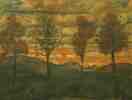 Four trees
Four trees
1917, oil on canvas, Osterriche Galerie, Vienna (90 Kb)
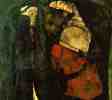 Pregnant Woman and Death
Pregnant Woman and Death
1911, oil on canvas, National Gallery, Prague (82 Kb)
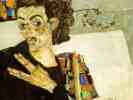 Self Portrait with black Vase
Self Portrait with black Vase
1911, oil on wood, Historiches Museum der Stadt, Wien/Vienna (100 Kb)
(thanks to Harlan Wallach)
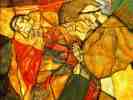 Agony
Agony
1912, Neue Pinakothek, Munich (130 Kb)
Man and monk. Very mosiac. Lots of reds, browns, oranges.
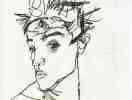 Self Portrait
Self Portrait
1913, pencil, National Museum Stockholm
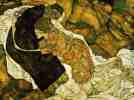 Death and Girl (Self-portrait with Walli)
Death and Girl (Self-portrait with Walli)
1915; Osterreichisches Galerie Wien, Vienna (120 Kb)
Girl clutching the figure of Death. His long boney
fingers in her hair.
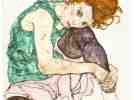 Sitting Woman with Legs Drawn Up
Sitting Woman with Legs Drawn Up
1917; Narodni Galerie, Prague (110 Kb)
The Austrian Expressionist painter Egon Schiele (1890-1918) died when he was only 28 and we do not really know whether he would have developed from the self-pitying adolescent angst that was the main theme of his work. Self-Portrait (1910; 110 x 35.5 cm (43 x 14 1/4 in)), however, is a most moving theme in itself: a pathetic and yet powerful exposure of Schiele's vulnerability. He is mere skin and bone, not yet fully there as a person. He has outlined his body with a glowing line of white to indicate to us both his sense of imprisonment and his limitations: notice how his arm disappears almost at the elbow-- yet paradoxically it also suggests growth and potential. He is an unhappy, scrawny youth, the wild and exaggerated expanse of pubic hair perhaps indicating the center of his unhappiness. It may seem too individualistic a view, yet in his hysterical way he is expressing the fears and doubts of many young people. He is wonderful, unsettling, and strangely innocent.
(thanks to Alexis Huxley)